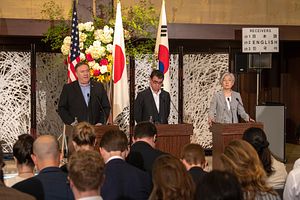On Thursday, South Korea’s Moon Jae-in administration decided not to extend an intelligence sharing agreement with Japan following escalating diplomatic tensions between the two nations.
Escalation is a legitimate tool of statecraft, but it pays to know who one’s true enemies really are. South Korea faces difficult and even existential challenges in a dangerous neighborhood. Japan is the least of Seoul’s problems and might even be the only genuinely benign nation for South Korea in Northeast Asia.
Consider the events which have occurred this year. On July 23, South Korean fighter jets fired more than 300 warning shots at a Russian military aircraft that violated airspace claimed by Seoul as the Russian plane was conducting a joint air patrol with China.
Around the same time, Japan scrambled its own fighter planes to warn off the Russian and Chinese lanes flying near islands claimed by both Japan and South Korea. Russian planes have never violated South Korea airspace in this manner and the joint sortie involving Chinese and Russian jets was unprecedented.
Or consider the six short-range illegal missile tests conducted by North Korea since July 25. Despite Moon extending the hand of friendship to North Korea’s Kim Jong Un, Pyongyang presents the only real existential threat to South Korea. Like his father and grandfather before him, Kim seeks the unification of the Korean Peninsula under his preferred terms.
One should also go back a few years for some salient lessons. When Park Geun-hye came to power in South Korea in 2013, she immediately signaled a move from the previous administration’s pro-American stance toward a more equidistant one between the United States and China. She described her first state visit to Beijing in June 2013 as a “trip of heart and trust.”
In the subsequent two years, South Korea basked in a diplomatic awakening with China, with the relationship described as the most intimate and warm for a generation. The economic relationship was as strong as ever. It culminated in Park attending the Chinese military parade and being given pride of place to mark the 70th anniversary of the end of World War II on September 3, 2015, even as the event was avoided by the United States, Japan, the European Union, and every democratic country in Asia.
Reality hit when North Korea conducted its fourth nuclear test on January 6, 2016. Park’s decision to deploy the U.S. Terminal High Altitude Area Defense (THAAD) anti-ballistic missile system — a completely reasonable response — enraged Beijing. In 2017, it is estimated that unofficial but real Chinese sanctions against South Korea cost the latter’s economy almost $7.5 billion.
In comparison, the spat between South Korea and Japan seems a distraction from the national interest for both countries. Last year, the South Korean Supreme Court ordered two Japanese companies to compensate wartime workers in a ruling that Tokyo believes violates a 1965 treaty offering closure to these issues. Recently, Tokyo took the step of banning certain high-tech exports to South Korea.
That ban could be reversed in return for Seoul being more willing to move on from regularly reigniting historical grievances. But the decision to end the intelligence agreement puts paid to any rapprochement between Seoul and Tokyo in the foreseeable future.
It is in neither country’s interest that relations between two of the United States’ democratic allies in Northeast Asia deteriorate to the extent that is occurring. But the consequences for South Korea will be worse than for Japan.
Under Prime Minister Shinzo Abe, the country has transformed itself into the most powerful and important U.S. ally in the region. Under the banner of making a “proactive contribution to peace,” Japan is joining Australia and the United States in defending what they call a “free and open Indo-Pacific” against the expansionist ambitions of China and Russia.
Seoul ought to be doing the same. It is a formidable Asian military and economic power. But Moon remains committed to the “Three Nos” he promised China in return for Beijing ending the informal trade boycott against South Korea that it imposed after Seoul deployed THAAD.
The “Three Nos” included no further U.S. anti-ballistic missile systems, no South Korean integration into a regional U.S. missile defense system, and no trilateral military alliance with the United States and Japan.
These concessions amount to a strategic reward to China after it caused billions in economic losses for South Korea when the former administration under President Park tried to protect its citizens.
At the same time, directing one’s ire toward Japan willfully ignores the reality that North Korea’s short-range missiles can only be aimed at South Korea.
The better move would be to persuade Beijing, Moscow, and Pyongyang that mischief-making against U.S. allies is counterproductive to their interests and will carry costs. The first step is for Moon to walk back the “Three Nos,” which would give South Korea a powerful card that it could play to its enduring advantage.
China is fearful that the integration of an enhanced U.S.-led anti-ballistic missile defense system with Japan and South Korea will severely compromise its own land-based missile offensive capabilities even if the system is ostensibly to protect U.S. allies against North Korea.
A genuine trilateral military alliance among the United States, Japan, and South Korea would profoundly spoil Chinese and Russian plans to divide and weaken U.S. allies. For the sake of the health of the U.S.-led alliance system and its own national interests, South Korea needs to obtain more leverage against China, Russia, and North Korea.
Extending the intelligence sharing agreement would have been one step in the right direction. Instead, South Korea remains confused about where the greater threats to its interests really lie.
John Lee, a former senior national security adviser to the Australian foreign minister, is a senior fellow at the Hudson Institute and the United States Studies Centre at the University of Sydney where he is an adjunct professor.

































